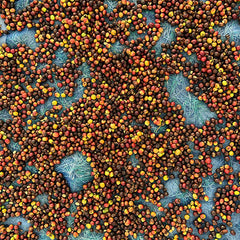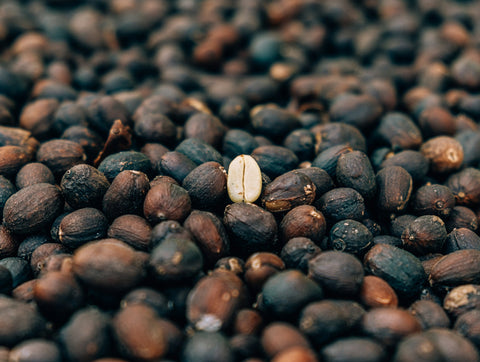Do you have a preference between washed or natural processed coffee, prefer Yellow Honey over Black Honey process? Maybe you are saying to yourself what is this all about, I don’t even like honey in my coffee! There are many coffee process methods and they all have a unique affect on the flavor profile of your cup.
A barista once asked me which of our coffees were vegan, they thought honey was actually used in the process, which for the strictest vegans would be a no go. I explained to them that all coffee is vegan and the different honey processes refers to the amount of mucilage left on the coffee during processing, no honey is used.
So, if you are a coffee fanatic you likely already know all the process talk and maybe even have a preference. I actually do not prefer washed over natural or anaerobic fermentation over a honeyed coffee. My preference has everything to do with the mood I’m in. Sometimes I feel like a clean, crisp washed coffee and others I want a pungent fruity double fermented coffee.
This article if for those of you who are on the cusp of jumping down the rabbit whole of specialty coffee and want to learn more about the coffee process methods and why you may prefer some coffees over others.
Let’s start with the basics.
Washed vs Natural
Washed and natural processed coffees are two distinct methods used in coffee production that result in different flavor profiles and characteristics.
Washed Processed Coffees
In the washed process, freshly harvested coffee cherries undergo several stages of washing to remove the outer pulp and mucilage before drying the beans.
Flavor Profile - Washed coffees typically have cleaner, brighter flavors with more acidity. This process often enhances the clarity of flavor notes, allowing for more nuanced tasting profiles. Washed coffees may exhibit floral, fruity, or citrusy notes.

Acidity - Washed coffees tend to have a higher acidity level, which contributes to their bright and crisp taste.
Body - The body of washed coffees is often lighter and more tea-like compared to natural processed coffees.
Consistency - Washed processing tends to result in more consistent flavors and quality due to the controlled fermentation and washing stages.
Natural Processed Coffees
In the natural process (also known as dry process), coffee cherries are dried whole, with the fruit pulp intact, before the beans are extracted. This allows the beans to ferment inside the fruit during the drying process.
Flavor Profile - Natural processed coffees often have a heavier body and more pronounced sweetness. They can exhibit a broader range of flavors, including intense fruity, winey, or fermented notes. The fermentation process within the fruit contributes to these unique flavors.
Acidity - Natural processed coffees tend to have lower acidity levels compared to washed coffees, resulting in a smoother, less tangy taste.
Body - Natural processed coffees typically have a fuller body with more mouthfeel due to the extended contact between the bean and the fruit during drying.
Consistency - Natural processed coffees may exhibit more variation in flavor and quality due to the natural fermentation process and the reliance on weather conditions during drying.
There are several different natural processes used in coffee production, each resulting in unique flavor profiles and characteristics. Some of the common natural processing methods include
Traditional Sun-Drying - This is the most basic and traditional method of natural processing. After harvesting, coffee cherries are spread out on raised beds, patios, or mats under the sun to dry. The cherries are turned regularly to ensure even drying. This process can take up to two to four weeks, depending on weather conditions.
Raised Bed Drying - In this method, coffee cherries are spread out on raised beds, allowing for better airflow and more even drying. Raised bed drying is often preferred for its consistency and control over the drying process, resulting in more uniform flavor development.
Patio Drying - Patio drying involves spreading coffee cherries on concrete or brick patios to dry under the sun. This method is commonly used in regions where raised beds are not available or feasible. Patio drying can produce natural coffees with unique flavor profiles influenced by the surface on which the cherries are dried.
African Beds - African beds, also known as African raised beds or African beds with shade nets, are similar to raised bed drying but with the addition of shade nets to protect the cherries from direct sunlight. This method is often used in regions with intense sun exposure to slow down the drying process and prevent over-fermentation.
Honey Process - Honey processing is a method used in coffee production where some or all of the mucilage (a sticky substance surrounding the coffee bean) is left on the bean during drying. This process can result in unique flavor profiles and characteristics in the final cup of coffee. There are several variations of honey processing, each named according to the amount of mucilage left on the bean and the subsequent drying process. Here are the main types:
White Honey - White honey processing involves leaving only a thin layer of mucilage on the beans, giving them a lighter coloration compared to other honey processes. The beans are often dried on raised beds or patios, similar to other honey processes. White honey processed coffees tend to have a lighter body and brighter acidity, with delicate floral and citrus notes.
Yellow Honey - In this process, some of the mucilage is left on the bean, giving it a yellowish color. The beans are then dried on raised beds or patios, typically for around 10-15 days. Yellow honey processed coffees tend to have a medium body and acidity, with flavors ranging from fruity to nutty.
Red Honey - More mucilage is left on the beans in red honey processing compared to yellow honey. This results in a deeper red coloration of the beans. The drying process is similar to yellow honey, with beans dried on raised beds or patios. Red honey processed coffees often have a fuller body and more pronounced sweetness, with flavors of ripe fruit and caramel.
Black Honey - Black honey processing involves leaving even more mucilage on the beans, resulting in a dark, almost black coloration. The beans are typically dried on raised beds and require careful monitoring to prevent over-fermentation. Black honey processed coffees are known for their heavy body, intense sweetness, and complex flavor profile, often with notes of dark chocolate, molasses, and tropical fruits.
These honey processes are highly dependent on the specific conditions during drying, including temperature, humidity, and airflow. As a result, each batch of honey processed coffee can have unique flavor characteristics influenced by the terroir of the coffee farm and the expertise of the coffee producer.
Anaerobic coffee processing
Anaerobic coffee processing is a relatively new and innovative method that has gained popularity among specialty coffee producers. In anaerobic processing, the coffee beans undergo fermentation in an oxygen-free environment. This is in contrast to traditional aerobic fermentation, where the beans are exposed to oxygen during fermentation.
The anaerobic process typically involves placing coffee cherries or pulped beans in sealed fermentation tanks or containers, which are then purged of oxygen. The lack of oxygen creates an environment conducive to anaerobic bacteria, which thrive in the absence of oxygen. These bacteria metabolize sugars and other compounds in

the coffee beans, resulting in unique flavor compounds being produced.
The fermentation period in anaerobic processing can vary depending on factors such as temperature, altitude, and desired flavor profile, but it typically ranges from 24 to 72 hours. After fermentation, the beans are washed and dried as usual.
Anaerobic processing can produce coffees with distinctive flavor profiles characterized by a wide range of flavors, including fruity, floral, and wine-like notes. The absence of oxygen during fermentation can lead to the development of complex and nuanced flavors that may not be achievable through traditional processing methods.
Double Fermentation Process
The double fermentation process involves two stages of fermentation, typically referred to as primary and secondary fermentation.
Primary Fermentation - After the coffee cherries are harvested, they are pulped to remove the outer skin, leaving behind the beans encased in mucilage. During the primary fermentation stage, the beans are soaked in water for a period of time, usually between 12 to 24 hours. This fermentation breaks down sugars and other compounds in the mucilage, which can impart specific flavors to the beans.
Secondary Fermentation - Following the primary fermentation, the beans are washed to remove any remaining mucilage and then undergo a second fermentation stage. During this stage, the beans are typically placed in a fermentation tank or covered container and left to ferment for an additional period, which can range from a few hours to several days. This secondary fermentation further develops and refines the flavor profile of the coffee beans.
The duration and conditions of both fermentations can vary depending on factors such as the desired flavor profile, altitude, temperature, and humidity. Proper monitoring and control of fermentation conditions are crucial to ensure the desired flavor characteristics are achieved without undesirable off-flavors or over-fermentation.
Double fermentation is considered an artisanal approach to coffee processing and requires careful attention to detail from the coffee producer. When done correctly, it can result in coffees with complex flavor profiles, enhanced sweetness, and unique aromas, contributing to a more distinctive and enjoyable cup of coffee.
Each of these many processing methods influences the flavor, acidity, sweetness, and overall profile of the coffee. The choice of processing method depends on factors such as local traditions, environmental conditions, and desired flavor outcomes.
Achilles Coffee offers a variety of washed, natural, honeyed, anaerobic and double fermentation processed coffees. Your preferences and brewing methods will determine which of these coffees fill your daily coffee crave.








